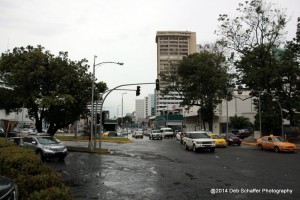
The gentle thumping against the window drew us out of the night. It’s raining in Panama City, which is not unusual in October. We’ve come to this Central American country to enjoy the sun, play some golf, and explore. Flying in during the early evening, we’ve stayed in a hotel downtown to avoid driving at night from the airport. As we traveled in this country, we discovered several planning strategies to help make your trip to Panama more enjoyable. With the advent of non-stop flights between Denver and Panama City, more tourists may make the trek.
1. Be prepared with basic Spanish. English is not widely spoken or understood. Tourism is new to Panama. Aside from the Canal and Bocas del Toro, the country hasn’t been much of a vacation destination for English speakers and most folks outside of Panama City only speak basic English. In the city, those in the hospitality industry may be more fluent but our waitress in the hotel restaurant still was puzzled when I asked for unsweetened iced tea. Be prepared with some rudimentary Spanish.
2. Rent a car to explore. Transportation is problematic. Officially, taxis are pretty inexpensive in Panama City. In reality, if you don’t know what it should cost, they charge you as much as they can get away with. From the airport to downtown Panama City, legally it should be about $12.00. In reality, it costs about $30.00 for a tired, non-Spanish speaking gringo.

Traffic is awful and this affects both private and public transportation. There is a country-wide bus system as well as flights to the major cities if you need to get to David or Bocas del Toro quickly. If renting a car, be prepared to drive very aggressively and take the comprehensive insurance. The condition of the roads range from good on the major highways to challenging in the neighborhoods. While my husband drove on the side roads, I kept an eye out for potholes that would swallow the front right quarter panel. Since many roads aren`t marked or named, GPS is not very useful either in the city or in the smaller towns. There aren’t many roads outside Panama City, particularly compared to most American urban areas. A good map is as useful as any GPS.
3. Arrange excursions before leaving home. Know who you want to call when you get in country for excursions. Our experience was that businesses that catered to tourists didn’t reach out or do much advertising. For example, we stayed in Coronado, a well-known resort area. My husband was interested in learning to surf, and we knew there were several well-known surf beaches close to where we were staying. We never found any information about any surf schools in the area. The resort didn’t have any brochure racks that we saw, and we never found a tourist office in town. We did plan on a day trip to El Valle before we left, and were able to drive there and enjoy the area. If there is something you want to do during your stay, arrange it or gather the information before you leave.

4. Be ready to shop. Stocking items that are not necessities is not high priority for Panamanians. There were no vendors on the beach, unlike the beaches in Mexico where vendors constantly approach visitors. For those of you who expect to shop for souvenirs, Coronado has many stores, but they don’t cater to tourists. We did see a couple of stores for the local artisans along the Pan American Highway, but didn’t want to stop at the time. There are also many vendors in Casco Viejo with a large variety of handmade goods. If you plan to return home with souvenirs, shop for them when you find them. The airport has mostly stores that cater to the high-end luxury goods crowd and very few T-shirts and shot glasses.
5. Ask about wireless service when booking a hotel. We had free Wi-Fi in the Doubletree in Panama City, at our resort in Coronado, and at the Country Inn and Suites on the Canal. My research indicates that not all hotels offer Wi-Fi, some offer it and charge, and some don’t. When booking accommodations, be sure to ask.
6. Talk to your cell provider. Cell coverage is fine in the bigger cities but may be less than stellar outside the most populated areas. We didn’t use our phone for calling or data on the cell network because it was too expensive. However, T-Mobile is offering international calling and data without additional charge. Check with your cell provider to determine what charges may be incurred in country. If you absolutely must have a phone, it is easy to buy a phone and load it up with minutes. Movistar and Cable & Wireless are the major cell providers in Panama and they have outlets in all the major Panamanian cities.

Spending time in Panama takes a bit more planning than the traditional resort vacation to, say, Mexico. Panama is still up-and-coming, and hasn’t focused on tourism like some of it’s neighbors. For those who prefer to explore and travel rather than visit and be served, Panama is a great vacation destination. Go, meet the people, and experience the deserted beaches and beautiful jungles. You’ll plan to go back.
Like this article? Click the subscribe link at the top of the page to get the latest information by email when it’s published. For more fun deals and information, follow Deb on Twitter at debtalkstravel.
